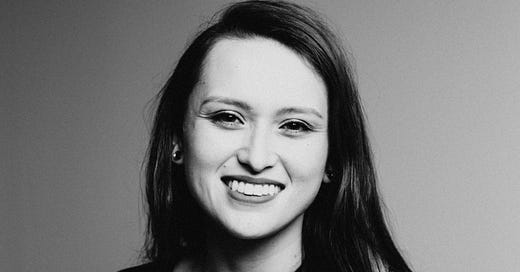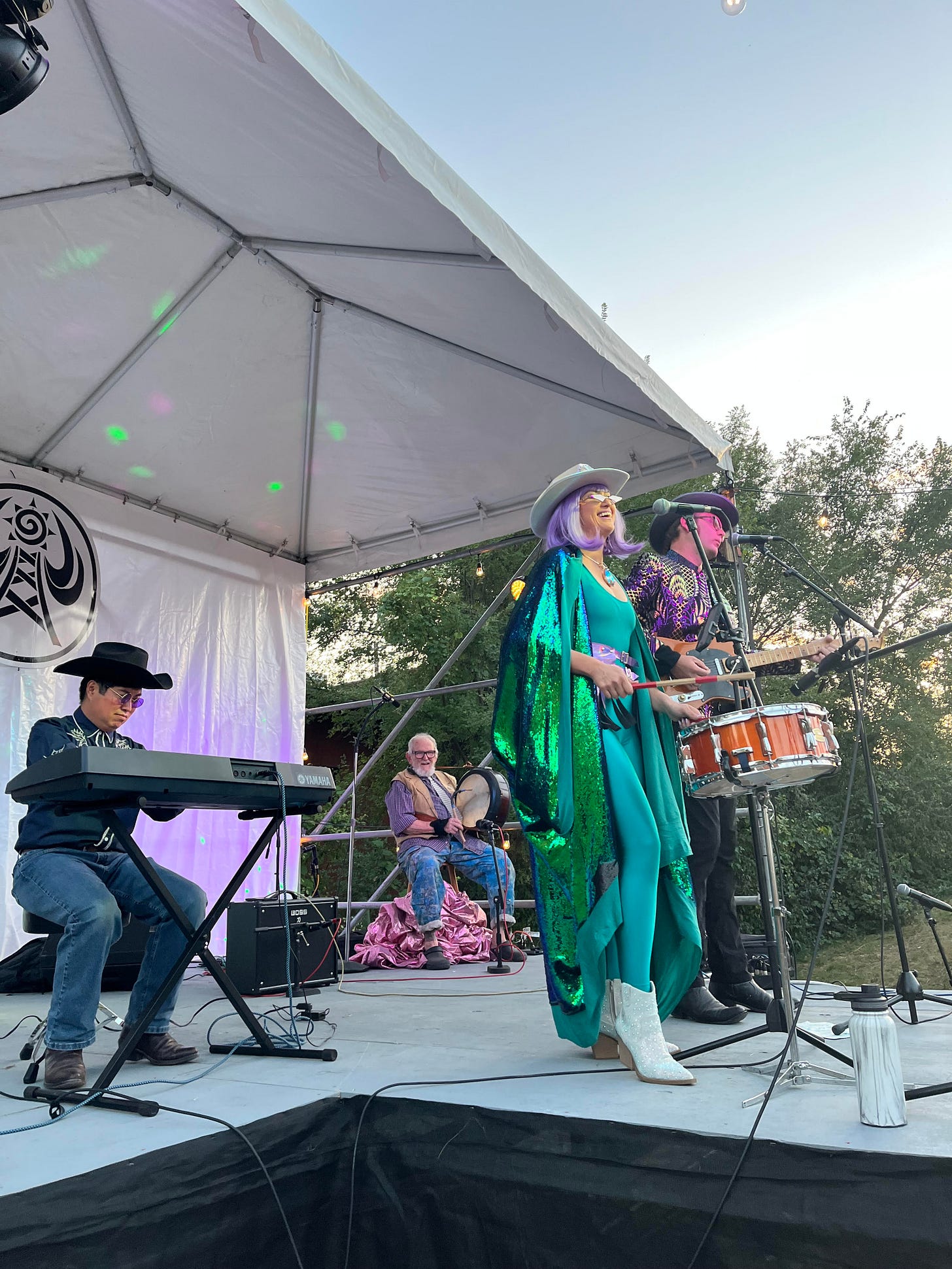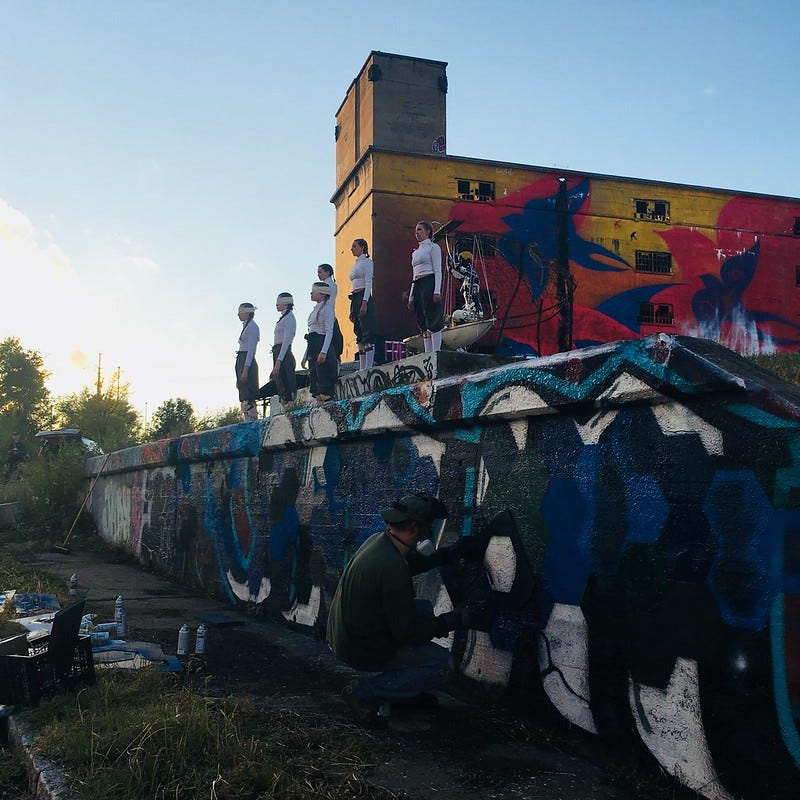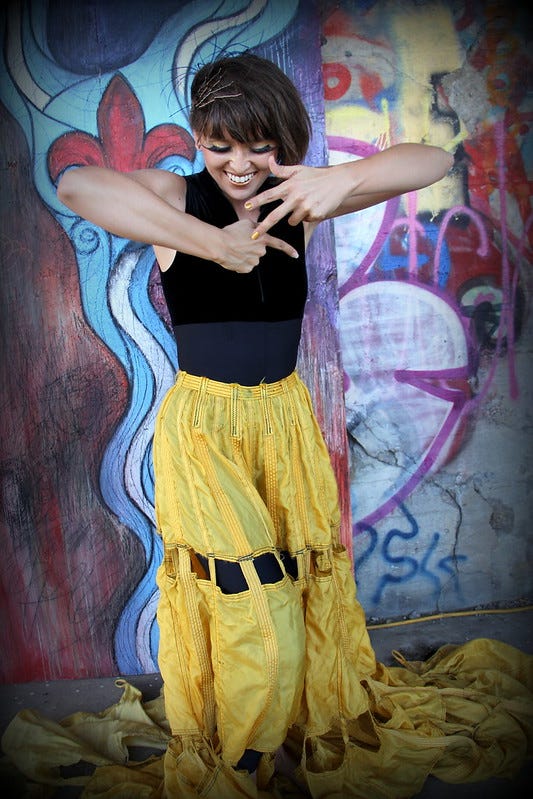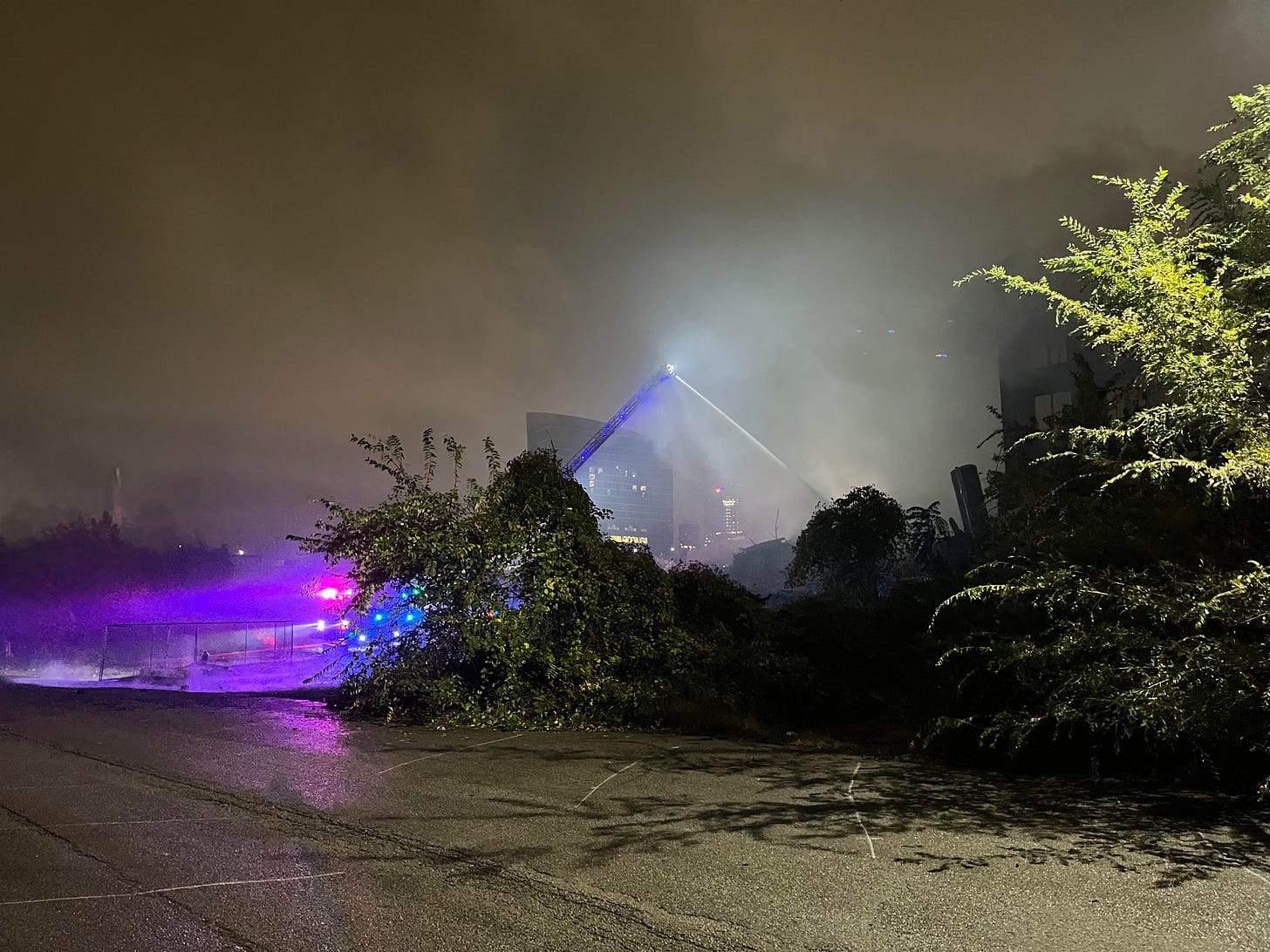This interview took place on December 9, 2022, on a brisk, breezy day outside of the Mud House; we regret the delay in posting. At the time, our subject, Audrey Simes, was a board member of Artica; she currently serves on Artica’s advisory board. She was joined by Dr. Bill Russell and his voice occasionally appears during this interview. An interview with him will follow.
Your board involvement. Let’s start with that.
Dr. Bill is the one who introduced me to Artica in the first place. I met him at Webster. He was my mentor in my self-designed major there and he was trying to rope me into the Artica world. That’s how I got introduced into Artica in the first place. And I just showed myself as a committed Artican in some ways and was approached by Nita, actually, to be a Board member. It was kind of a growth year. There were some other new members at the time and they were starting to shift gears in terms of thinking about transitioning their leadership and they were expanding the Board. That’s how I came into it. It was supposed to be a three-year term and it’s almost been 10 years now. And that’s generally how things have worked on the Board. Many, many years of service.
You’ve also had performance roles, too.
Yeah, of course. Actually, the last piece that I worked on was in 2019. That was a collaborative piece. Prior to that I had almost made a piece since 2009, 2010, somewhere in there… 2009 was my first piece, a collaboration. It was all performance-based, installation, multi-disciplinary work. Performance art or dance.
Bill: I thought you did a piece before then?
No. That was the first piece. One after another. We’d simulate a whole year’s worth of work basically, different collaborations that were stemmed from Artica. The funds that I was awarded from Artica catapulted different projects from there. Or closed a chapter, as well. As in 2019, that was the closing of a chapter of a three-part series. And since then, I haven’t done anything creatively at Artica. {ed: This changed with a 2023 performance with Drew Sheafor on the Community Stage.}
But you’ve obviously still had a stamp on things.
Oh, yes. Especially in regards to the Community Stage which originated as a project. It was a proposed project that was collaborative. We built it, a team of us, that first year. I want to say that was 2017 or 2018 for the first Community Stage. And since then we’ve worked to make it what it is today. Of course, I’ve done lots of other things. Communicating with artists. And doing a lot of artist outreach. Basically, talking about Artica everywhere I go.
In your mind, how has programming changed since your initial involvement?
Programming has actually gotten smaller because our organization capacity has gotten smaller. There’s a bit of growth in defining what our principles and values are; that took us some time to figure out. Some – some – in the organization view the Artica festival as what Artica does, whereas I think of it as a much bigger entity, a spirit. Something you can take wherever we go. Whether it’s at a workshop or other, smaller events. That being said, right now, we only have the capacity to do one festival and all of the preparations that requires. We barely have the capacity to do that.
There’s been sort of an in/out of a small staff, especially closer to the event. How important is it in your mind that there would be, to some degree or another, a standing staff component?
It’s the most important aspect of what Artica’s missing right now. Absolutely. We need to balance our volunteer effort (that includes board membership) with a staff that can take on the work that the board has been doing for many years. And this has just been a consistent issue, basically. The board members end up doing all the work. But like I said, we don’t have the capacity; meaning we also don’t have the financial capacity. We’re still working with a budget that’s pretty small. So that makes us not even eligible for certain grants because of that.
2022: can you break out that year specifically because you had two years which were definitely impacted by Covid. And this year was more normal. Do you feel this year was a little bit more normal in the context of Artica?
I think it was beyond normal. I think it was remarkable what happened this year, especially given how small our team was. We lost two board members this year. We doubled in size, then came right back down in size after losing one after another. We lost several people, key members. I’m amazed that we were not only pulling it off – as we’re all personally dealing with the repercussions of the pandemic, as well — and yet it was actually one of the best years. I heard from many people that it was perceived as one of the best years of Artica ever. I think because we didn’t shut down, because we were still able to do (in a safe way) what we do, even in 2020 and 2021, we didn’t lose as much momentum as we might have.
How important was it to have the events, especially in 2020? That there was some version of the event?
It was incredibly important. There was a lot of discussion and several people were not supportive of it ultimately and we had to navigate that in different ways, you know. We did everything possible to make it not only up to the standards of every agency of government but to ourselves and our people. I think it was incredibly important. It’s a place where we could actually see people and bond and interact in ways over distance. That year, definitely, was unique.
It used to be that Sunday was for closing things down and cleaning up and now that’s Monday. Was it important to have the weekend built the way it is now?
There’s always room to change the format up a bit. I think we could do as a one-day event. And actually pool all of our energy. We’ve had so much to support: the music and different events that happen over two days. I’m not really sure that we could cram it all in, but I think that we would see so many more people for the Boat of Dreams Parade. All of that would be condensed. But I think people enjoy relishing the whole weekend.
There are the technical or operational challenges, like “Oh, all the entry points to the river are closed.” Some of those things present themselves and always demand a response.
Yeah, I mean, we’re dealing with those conversations all year long, every year. This year, for example, conversations about security, about having the ability to pay someone to stay overnight (and not just to rely on the folks that live there to be our protectors) that has come up. Infrastructure is a huge conversation on the whole. Having more accessibility, more safety. The golf carts were a huge deal this year. That was a very big step for an organization that used to sort of scoff at providing infrastructure it’s a good thing. Absolutely.
I’m also thinking here of the potential of the Rams stadium at one point…
Oh, it’s that every year. I mean, the weeks leading up to it, we were uncertain about it. We were looking for new locations. And very seriously. For the first time, it seemed imminent.
The Cotton Belt Building. What’s the role of it at this point?
It’s just a beautiful backdrop. That’s how I describe it. Artica’s situated with the backdrop being the Cotton Belt and the river, of course. In a way, the bookends are the length of the river and the length of the Cotton Belt. But I think it holds a lot of nostalgia for people who’ve been around Artica for a long time, obviously. (Pause.) I think it’s more than just a backdrop. The presence of the piece that Hap and Nita did, Migrate, that’s to me such an anchor point for Artica. A reminder of where we came from. And where we’re going, because that’s the whole intention of the work, itself. I take it back: it’s not just a backdrop. I think I’m just resentful that we can’t use it for installation and performance.
Dr. Bill: The function has changed.
The function has definitely changed. But I see it very much as an anchor point.
This might seem like a silly question, but I’ve never known: are the fields named separately? Because I’ve always thought of them as the lower field and the upper field. That might be in my own head, but I’ve always said, “oh, I’m going up to the upper field.” Is there an actual title?
There is a little confusion, because (we) used to call the lower field, where the cottonwood tree is. There are permanent resident folks down there, so we don’t use the lower field.
There was a fire nearby recently, like right at the doorstep to Artica. That’s the kind of thing that can happen rapidly and just due to a match. I guess that’s the same conversation, about a space that changes pretty radically. What’s the thrill about working with that sort of uncertainty as opposed to having things be set?
That’s a part of Artica. At least up to this point. If we move the site, that will change that aspect of the experience and how we as artists interact with it and how the participants interact. There’s sort of an inherent bit of fear of the unknown that comes with participants, especially. There’s a lot of crime, there’s a lot of uncertainty. We don’t do a lot to provide a sense of security. At the same time, we’ve been lucky that no major incidents have occurred at Artica, where we’ve had to have police involvement. You know, robberies or assaults. As far as I know, in the 20 years, or so that Artica has has been around, I don’t think there’s been any instances. There’s the one example of when Tim broke his pelvis. It’s a hairy location. And some of the people who've been integral in keeping this organization alive suggested that if we move the festival from that site, it is no longer Artica. But I’m not one of those people.
Are there singular or even batched events that have defined Artica for you? Where you say, “ah, this is why I do this, this is why I work on it?”
Well, there’s always this thing that happens at the Boat of Dreams Parade. Without fail. Even in the toughest years, where me and my collaborators were devastated for whatever reasons, it still was this grounding. We’re charging forward. That to me, seeing people parading together, is something that I find really beautiful. The people who are inclined to parade, like us, there’s a reason why we have to celebrate in that way. I want that to be more so, I want to bring awareness to that. It’s a huge part of our celebration that very few people really experience. Especially compared to the burn. If you took that many people and paraded together somehow, that would be incredible. That’s one, I would say. That’s consistent, year after year. And especially when we used to be able to go to the river. Obviously, that’s changed now, too.
Kind of in line with that… Johnny Vancouver’s had a role year after year. Other artists have done the same. What’s to you, the value of having some degree of consistency and then having new elements blended in?
I think you hit it right on the head. That’s an important aspect of any art event. You need something accessible that invites them in and then something that challenges people. We could do a better job of that. There are some people stepping up in the Artica community that are finding ways to invite people into the experience in better ways. Instead of just having these assumed “this is how we do things” and we don’t have ways of communicating that. For example, simple things like just creating a map. It took several years for that to happen. Right now, the suggestion is: why not have little placards with numbers connected to the artwork? Stuff like that never would’ve been considered in years prior. That was just infrastructure and that would’ve had to fall on the board of directors and it does. I would say key volunteers and staff people have really stepped up for good changes. Adie Bennett is key to the growth of Artica at this point. She took on so much. And Jasmine Raskas. She sent us a list like this {holds hands apart} of things that could help improve the situation. As old people, me included, are pulling away, I’m excited to see that there’re new people in the community wanting to step up. That’s really exciting.
Two more things and I’ll flip it around to Bill. The role of guerrilla performance – non-funded breakouts – to what degree is that monitored, frowned on, supported. Guess it depends on what’s happening. For example, if there’s something clashing with what’s already programmed. I won’t name names, but sometimes there’s been a clash and it feels intentional…
Yeah, we often have to strike a balance in some ways. I’ve had moments where I’ve had to talk to people as a representative of the organization. And to be a woman and to be younger than the people I’m talking to and having to establish a role in a way that’s authoritative… it’s a tricky balance. We want that break-the-rules thing that inspires you but when does that infringe on somebody else? It’s rare that that happens. The whole idea is that you come to Artica to participate, to contribute and create and all of this. There were a couple of train-hoppin’ gutterpunk kids this year playing guitar and they set up their sign asking for money. And, so, at Artica that’s not allowed. So I have to go up to these train kids and basically say to them, “I’m so sorry, you can’t capitalize on this moment here. Even if you’re struggling as much as any of us artists here making sculptures.” That was really tough. That might be different from what you’re thinking of, bull-headed artists who make a statement. But that was actually a little more-ethically challenging to navigate that moment. I’m supposed to tell these people, who’ve just as much have this space as it’s our space, to not play. I dunno. It just weirded me out.
I had a friend with a restaurant downtown for a long time – well, he had several projects – but he had this one line that I remember to this day. He was bummed that a mayor of longstanding had never come in. And he said, “I wish he’d just come in and have a burrito.” That stuck with me to this day. Is there ever a notion like “it’d be nice if a mayor or an X, Y or Z official came by and acknowledged us?” Or is that a “naaaah?”
I think at the core of Artica is this very anti-establishment, anti-... just anti-. When I think of Nita and what she stood for, I don’t think that was ever on the radar. Or even to be accepted by whatever art community’s already existing in St. Louis and that’s kinda what makes it so insular in a way. But at the same time, I respect that. It’s something that she was not about, playing certain games. But we also get public funding. We get government money to create an event that is so anti-. It’s funny. We don’t know how to reconcile that issue, either. Despite the fact that we’re so anti-commerce; our value is decommodification, right? So I think that’s where we resolve the issue in our minds.
-30-

